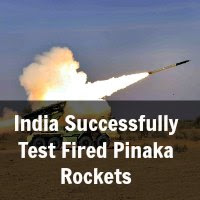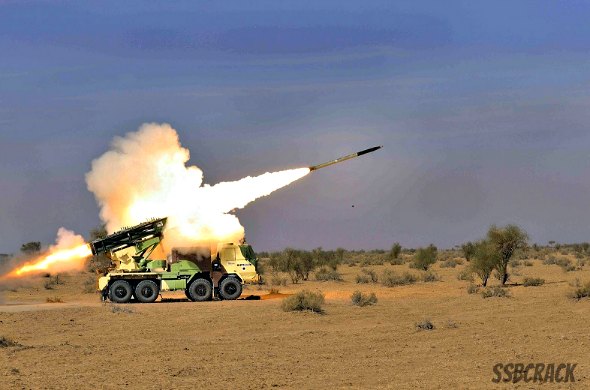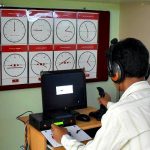Pinaka was test fired successfully from the range of Chandipur-on-sea on 19th december 2013. Pinaka is multiple barrel rocket launcher produced by defence research and development organization (DRDO) for the Indian army. Pinaka rockets played an important role in the kargil war to neutralize the enemy’s power on tiger hill.
Development of Pinaka started in 1986 as the replacement of BM-21 grad1 launchers and the tests were started from 1995.These tests are as a result of the recent development in the rocket system as it has been upgraded to second generation mark II launchers. The older version has a range of 40 km and the latest version now has the strike power of beyond 55km. Pinaka mark-ii will undergo some more tests before been inducted into the army. Pinaka battery consists of: six launcher vehicles, each with 12 rockets; six loader-cum-replenishment vehicles; three replenishment vehicles; two Command Post vehicles (one stand by) with a Fire Control computer, and the DIGICORA MET radar.
The Important features of Pinaka is
- The strike range has been increased from 40 to 55 kms.
- Microprocessor allows the system to be fully automatic as well as manual control
- Use of console makes it easy to use and control the launchers.
- Night vision gears for the driver and the crew.
- Neutralization/destruction of the exposed troop concentrations, ‘B’ vehicles and other such soft targets
- Cabin pressurization for crew protection in addition to blast shields
- Total operational time optimized for shoot & scoot capability.
- Cheaper in cost then the other Multi barrel rocket launchers systems.
- Precise and effective and the accuracy is very high.
- Indigenously developed and the designed according the requirements of Indian army.
Modes of Operation
- Autonomous mode: In the automous mode the microprocessor plays an important role The launcher is fully controlled by a fire control computer (FCC). The microprocessor automatically executes the commands received from the FCC and it executes the precise coordinates, giving the operator the status of the system on displays and indicators.
- Stand-alone mode: In this mode, the launcher is not linked to the fire control computer(FCC) , and the operator at the console enters all the coordinates and the commands for laying of the launcher system and selection of firing parameters.
- Remote mode: In this mode, a remote control unit carried outside the cabin up to a distance of about 200 m can be used to control the launcher system, the launcher site and to unload the fired rocket pods from the launcher.
- Manual mode: All launcher operations including laying of the system and firing are manually controlled. This mode is envisaged in the situations where the microprocessor fails or where there is no power to activate the microprocessor-based operator’s console.
Also Read
- Contact Details Of Indian Army
- About Territorial Army India
- Formation and Structure of Indian Army
- Some Facts about Indian Army
- Major Exercises of Indian Army
 Anurag Joshi, Editorial Team
Anurag Joshi, Editorial Team













